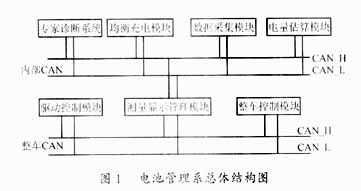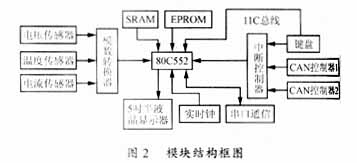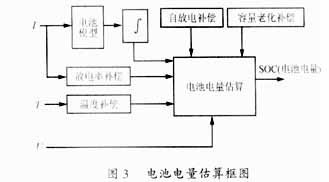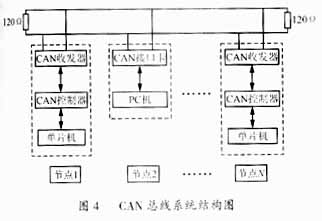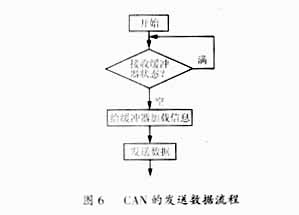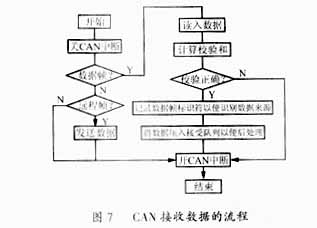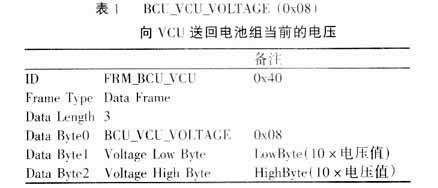With the rapid development of high technology and its industry, battery energy systems with large storage capacity have been paid more and more attention by people, and have been widely used in many fields, such as new directions and new hotspots in the development of the automotive industry. - In the research and industrialization of electric vehicles and hybrid vehicles, it will be the main supplier of vehicle energy. The battery pack is composed of a series of single cells connected in series, which can be charged and discharged hundreds of times to thousands of times; in use, attention must be paid to the characteristics of each individual battery, battery temperature, remaining battery power and total Parameters such as current, because these parameters directly affect the service life of the battery, must be optimized operation and effective monitoring to prevent battery overcharge, over discharge and excessive temperature, thus prolonging battery life and reducing costs, especially improve Battery reliability. The electronic, control, and digital technologies that power the battery pack can be called digital "battery electronics." Also in the electronic and digital technology of automobiles, multiple CPUs have been used to complete the control of various parameters and functions. Considering the safety of the car, the operation must be very reliable, so the development of parallel independent multiple system structures, and then by the scene Bus connection, forming a unified large system. 2 distributed structure management system 2.1 system structure The system must realize different types of functions, centralized or central processing methods can not meet the security requirements, naturally adopt a distributed structure; the system's working environment is harsh, often under the interference of strong electromagnetic interference and pulse current, in order to ensure reliability Sexuality, consider adopting and developing a high-performance CAN field bus as a communication system; and the CAN bus has been used for a long time in automobiles, and has strong anti-interference. At the same time, the technology is relatively mature and has become the standard for communication in automobiles. Therefore, the internal communication of the system and the external communication are implemented by the CAN bus. The distribution system is designed with the CPU80C552 as a common module platform. Due to the limited storage space of the CPU and the limited operation, multiple CPUs must be used to implement various functions required by the management system. The completed basic system consists of four modules in parallel: data acquisition, equalization charging, power estimation and communication display; each module realizes its function, and carries out data communication through CAN bus, which can realize single battery voltage, total voltage, charge and discharge current, Temperature collection and measurement, electricity estimation. At the same time, the system is also highly scalable, enabling research and development of specific battery diagnostics and battery safety performance protection. In the lithium battery management system, 108 batteries use 9 measuring boards, plus 4 basic boards, for a total of 13 boards. 2.2 Management system main module design The main functions of the system include data acquisition, power estimation and display diagnosis. Because the 80C552 has eight 10-bit A/D conversion functions, the acquisition module first uses the linear optocoupler method to measure the voltage of the single cell, and converts the analog quantity into a digital quantity into the memory through its four A/D ports. The measurement uses a single-bus technology that uses a Dallas digital chip to measure temperature. The chip has a 12-bit accuracy level that measures the temperature of the system very accurately. The total voltage and current signals are converted into 0 to 10V signals by special sensors, and converted into digital quantities by the 14-bit A/D conversion device. The communication and display module provides dual CAN communication interface, which can transmit data with CAN through various modules and external vehicle systems in the system. At the same time, the system provides RS232 interface, which can communicate with PC. The module also provides 5-port half-liquid crystal display. Drive function, and button for human-machine friendly operation; module also has voltage, power, current and temperature upper and lower limit alarm and self-test function to ensure system security. The basic block diagram of each system module is shown in Figure 2. 2.3 electricity estimate The electric quantity estimation adopts the real-time current integration ampere-hour method for basic estimation, and then corrects various parameters such as temperature, self-discharge and aging which affect the battery power, and considers the inconsistency between the single batteries, thereby obtaining an accurate battery pack. Electricity. 3CAN bus system 3.1CAN Introduction The CAN bus is a kind of field bus. It is a serial high-speed data communication bus developed by Bosch in Germany in 1986 to solve the data exchange between many control and test instruments in modern automobiles. It uses the physical layer and data link layer in the seven-layer structure of the ISO/OSI model, with high reliability, real-time and flexibility. The CAN bus has the following unique advantages: 1) CAN can work in multi-master mode. Any node on the network can send information to other nodes on the network at any time, regardless of master-slave, and the communication mode is flexible; 2) CAN can transmit and receive data in point-to-point, point-to-multipoint and global broadcast. The communication medium adopts twisted pair, coaxial cable or optical fiber, and the choice is flexible. The communication distance can be up to 10km/5kb/s, communication The rate can be up to 1Mb/s/40m. The number of nodes on the CAN depends on the bus drive circuit, which can actually reach 110; 3) In the case of a serious error, the CAN node has the function of automatically turning off the output, cutting off its connection with the bus, so that other operations on the bus are not affected. Adopt NRZ encoding/decoding method and adopt bit filling technology. The user interface is simple, the programming is convenient, and it is easy to form a user system; 4) CAN adopts non-destructive arbitration technology. When two nodes transmit information to the network at the same time, the node with lower priority actively stops data transmission, and the node with higher priority can continue to transmit data without affecting, effectively avoiding the bus. conflict. 5) CAN adopts short frame structure, each frame is 8bite, the transmission time is short, the probability of interference is low, and each frame of information has CRC check and other error detection measures, which ensures the data error rate is extremely low. 3.2CAN bus design The overall structure of the CAN bus is shown in Figure 4. Two 120Ω resistors are arranged at both ends of the bus. The function of the bus is to match the impedance of the bus, which can increase the stability and anti-interference ability of the bus transmission and reduce the error rate in data transmission. The CAN bus node structure is generally divided into two categories: one is connected with a PC using a CAN adapter card to realize communication between the host computer and the CAN bus; the other is composed of a single chip microcomputer, a CAN controller, and a CAN driver, as a class. The node transmits data with the CAN bus. In this system, the CAN controller adopts SJA1000 and 82C200 produced by Philips, which acts as a transmitting and receiving buffer to realize data transmission between the main controller and the bus; the CAN transceiver adopts PCA82C250 chip, which is a CAN controller. The interface with the physical bus can mainly provide differential transmission capability to the bus and differential acceptance capability to the CAN controller. 4CAN bus software design The three-layer structure model of the CAN bus is: physical layer, data link layer and application layer. The functions of the physical layer and the data link layer are completed by SJA1000. The development of the system is mainly in the design of the application layer software. It mainly consists of three subroutines: the initialization subroutine, the sending data and the receiving data program. At the same time, it also includes some data overflow interrupts and the processing of frame errors. After the power-on hardware reset, the SJA1000 must be initialized by software before data communication. The initialization process mainly includes configuring the clock divider register CDR, bus timing registers BTR0 and BTR1, acceptance code register ACR, and acceptance in its reset mode. The mask register AMR and the output control register OCR, etc., define the bus rate, acceptance mask, output pin drive mode, bus mode, and clock division. The specific process is shown in Figure 5. The following is the flow of sending and receiving data to the SJA1000. The basic process is to save the data to the SJA1000 transmit buffer, and then set the TR flag of the command register to be set and start transmitting. The receiving process is SJA1000 will receive from the bus. The incoming data is stored in the receive buffer, and the main controller is notified by the interrupt flag bit to process the received information. After the reception is completed, the buffer is cleared and waiting for the next reception. The specific process is shown in FIG. 6 and FIG. 7. For example, the format of the total voltage sent by the battery management system to the vehicle system is listed in Table 1. Wherein, the ID is the address of the receiving node bus, the voltage value is multiplied by 10 and then transmitted, and 0x08 indicates that the content of the transmitting frame is the voltage of the battery pack. 5CAN bus application problem In the hardware aspect, reasonable power supply must be considered, pay attention to the power supply of each CAN device, the filtering between the ground, and the design of the reset circuit. At the same time, when actually designing the printed circuit board, reasonable wiring, strengthen the ground wire, and enhance the system. Anti-interference. In software design, the setting of the CAN bus timer is very critical. BTR0 determines the propagation time period, phase buffer segment 1 and phase buffer segment 2; BTR1 determines the synchronization jump width and the division value. In the bit timing register, the values ​​set by TSEG1, TSEG2, SJW, and BRP are one less than their function values, so the setting range is [0.....N-1] instead of [1.....N]. Therefore, the bit time can be obtained by [TSEG1+TSEG2+3]tq or [synchronization segment + propagation segment + phase buffer segment 1 + phase buffer segment 2] tq, where tq is determined by the system clock tSCL and the baud rate prescaler value BRP Decision: tq=BRP/tSCL. At the same time, it should be noted that since the CAN system clocks of different nodes are provided by different oscillators, the actual CAN system clock frequency of each node has a tolerance with the actual bit, the change of the ambient temperature and the aging of the oscillator affect the initial tolerance. In order to ensure accurate data transmission, it is necessary to ensure that each node's CAN system clock frequency is within a certain frequency tolerance limit. Therefore, when selecting an oscillator, the node with the highest tolerance to the oscillator tolerance range is required. quasi. Moreover, in an expandable bus structure, the maximum node delay and the maximum bus length must be considered. In general, the delay is 5.5 ns/m. In actual operation, the CAN bus is not connected or the bus is suddenly turned off. The main reason is that the frame loss phenomenon occurs during data transmission, which causes an error. When the error counter reaches a certain value, the bus is automatically turned off. The ES state of the error state must be determined in time during the software design process. In the event of an error, the SJA1000 needs to be software reset to resume communication. 6 conclusion In the development of the battery management module of the "863 major special" electric vehicle, it is a distributed structure using CAN bus communication. The test results of the nickel-hydrogen battery pack and the lithium battery pack show the advanced structure of the system, realize the unique function of each module, work normally and reliably, and the number of nodes of the CAN bus of the lithium battery system increases to 12, Under strong electromagnetic interference, it still works normally, and the line connection is very simple and practical. The parameters, measurement methods, number of batteries, and safety requirements of the two battery packs are different, and the grouping is different, but the system can be effectively adapted, reflecting that it has good adaptability and greater flexibility. Gear Pump,Hydraulic Gear Pumps,Car Lifting Machine Gear Pump,Hydraulic Pump Assembly Huai'an Aide Hydraulic Machinery Co.Ltd , https://www.aidehydraulic.com